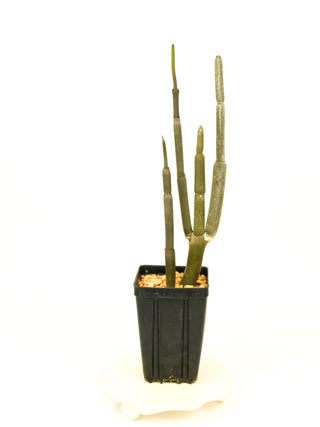Ceropegia fusca is a striking and unusual species of succulent plant belonging to the Apocynaceae family, native to the Canary Islands. Like many members of the Ceropegia genus, it is best known for its distinctive and elaborate flowers, which are adapted to trap and temporarily hold insects for pollination.
This species typically features slender, twining stems that can grow quite long, often scrambling over rocks or nearby vegetation. The leaves are small, fleshy, and opposite, though they may be sparse or even absent on mature stems. The flowers are tubular and elongated, usually a dark brown to purplish-brown color with a fused corolla forming a cage-like structure at the top — a unique characteristic that gives Ceropegia species their nickname “parachute flowers” or “lantern flowers.”
Ceropegia fusca thrives in arid, rocky habitats with well-draining soil and is adapted to survive in dry conditions. It is a popular species among succulent and caudiciform collectors due to its unusual form and intriguing floral structure. Like many Ceropegia species, it relies on fly pollination, using scent and structure to temporarily trap insects, aiding in cross-pollination.
In cultivation, it prefers bright, indirect light and infrequent watering to prevent rot, making it suitable for xeriscaping or container growing in dry climates.
Ceropegia fusca is a striking and unusual species of succulent plant belonging to the Apocynaceae family, native to the Canary Islands. Like many members of the Ceropegia genus, it is best known for its distinctive and elaborate flowers, which are adapted to trap and temporarily hold insects for pollination.
This species typically features slender, twining stems that can grow quite long, often scrambling over rocks or nearby vegetation. The leaves are small, fleshy, and opposite, though they may be sparse or even absent on mature stems. The flowers are tubular and elongated, usually a dark brown to purplish-brown color with a fused corolla forming a cage-like structure at the top — a unique characteristic that gives Ceropegia species their nickname “parachute flowers” or “lantern flowers.”
Ceropegia fusca thrives in arid, rocky habitats with well-draining soil and is adapted to survive in dry conditions. It is a popular species among succulent and caudiciform collectors due to its unusual form and intriguing floral structure. Like many Ceropegia species, it relies on fly pollination, using scent and structure to temporarily trap insects, aiding in cross-pollination.
In cultivation, it prefers bright, indirect light and infrequent watering to prevent rot, making it suitable for xeriscaping or container growing in dry climates.

